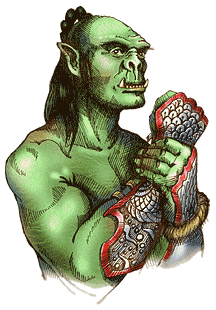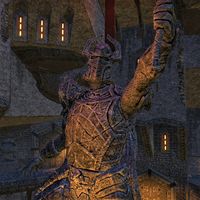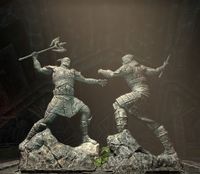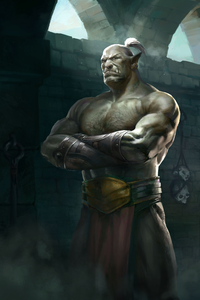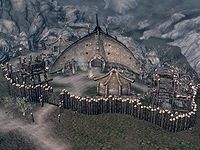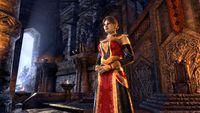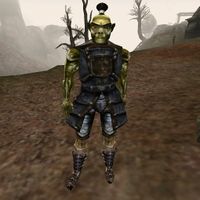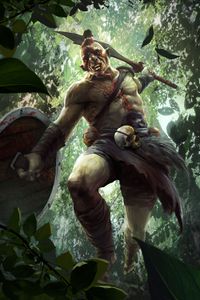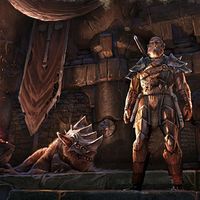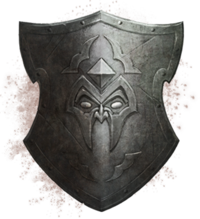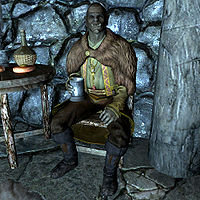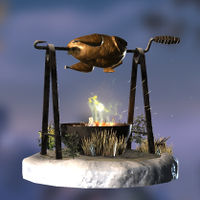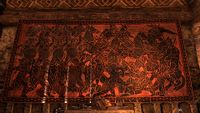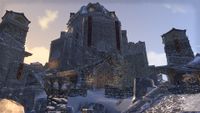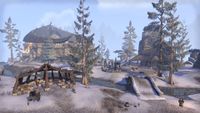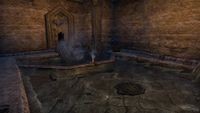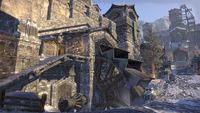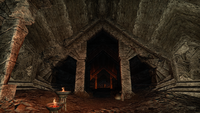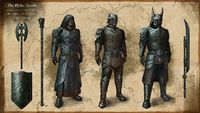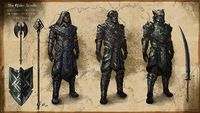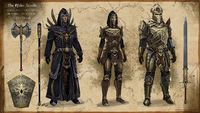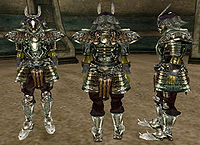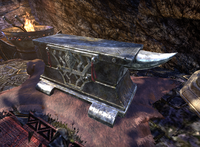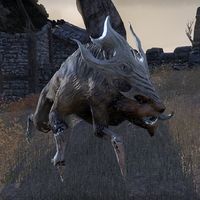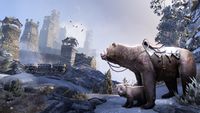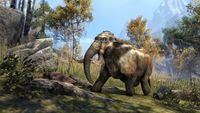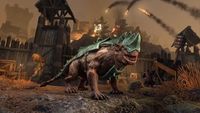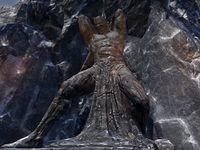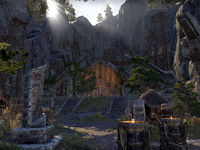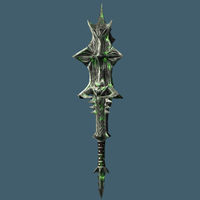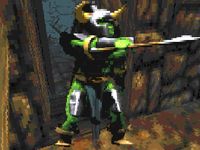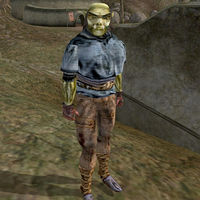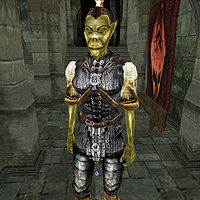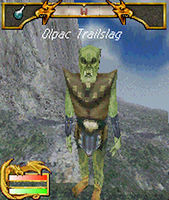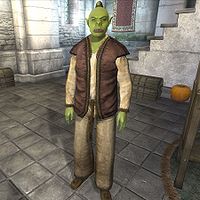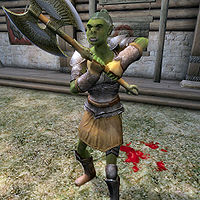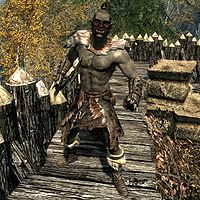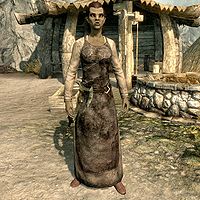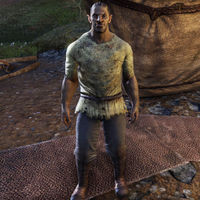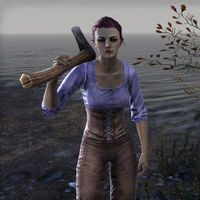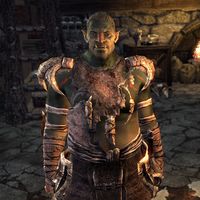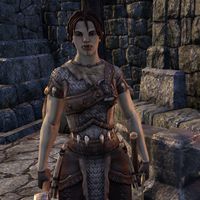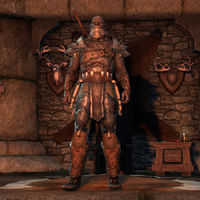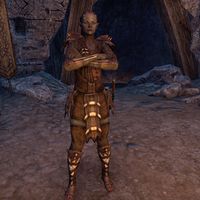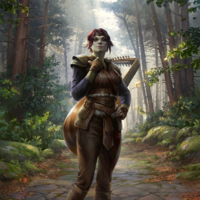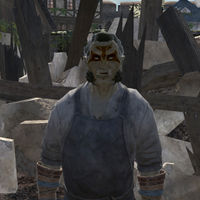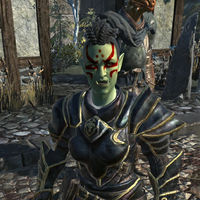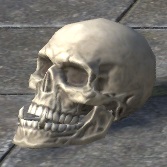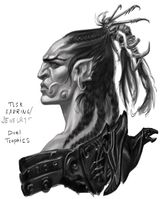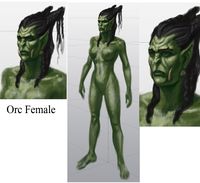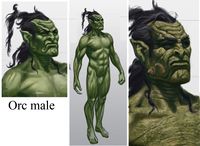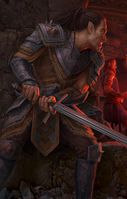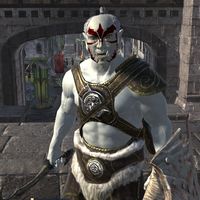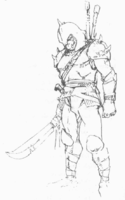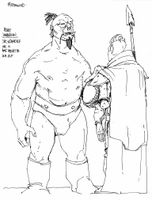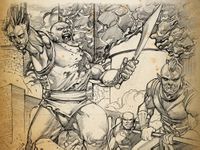Lore:Orc
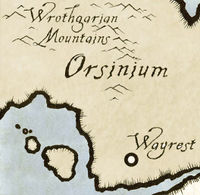
Orcs, also called Orsimer (Aldmeris: Cursed or Pariah Folk) in ancient times (as well as in modern times by followers of Trinimac),[1][2][3] and Ornim in their native tongue,[4][5][6] are the people of the Wrothgarian Mountains, Dragontail Mountains, Valenwood, Skyrim, northern Morrowind, and Orsinium (literally translated as "Orc-Town").[7][8][9] They are noted for their unshakable courage in war and their unflinching endurance of hardships.[8] Orcs have elven blood,[10] but are sometimes grouped into Beastfolk,[11][12][13] specifically Goblin-ken.[7][14][15]
In the past, Orcs were widely feared and hated by the other nations and races of Tamriel and were seen as nothing more than uncivilized beasts, savage barbarians.[16][17][18] The Orcs are as civilized as any of the other races, having worked hard to be seen as actual people.[19][nb 1] They have slowly won acceptance in the Empire, in particular for their distinguished service in the Emperor's Legions. Many Orcs in the Third Era have actually received an Imperial education as a benefit of serving the Imperial Legion.[19] Orc armorers are prized for their craftsmanship, and Orc warriors in heavy armor are among the finest front-line troops in the Empire, and are fearsome when using their berserker rage.[20]
Orcs have a lifespan similar to that of humans, possibly because according to the Nords, Shor passed a curse Orkey had placed on the Nords onto the Orcs.[UOL 1][21] Orc's blood has alchemical properties, and is also known as the "Rising Sun".[22][23][24] While many Imperial citizens regard Orc society as rough and cruel, the Orcs consider themselves to be stern, fair, and just.[19] Orcs have their own language known as Orcish.
Origins[edit]
| Elven | Beastfolk |
|---|---|
|
"When Boethiah grew bored of Trinimac's torture, she released him from his prison and later exiled him to a plane of choking ash. This torture and dishonor left Trinimac twisted and enraged. Trinimac faded and was reborn as Mauloch, the God of Curses. With his mind bent on revenge, his most devout followers changed to match him and became the Orsimer, cursed to wander in exile, a people without a place."
—The Fall of Trinimac According to various accounts, the Orcish race was created when their patron god Trinimac was transformed by Boethiah. He became Malacath (or Mauloch) and his faithful elven followers became the cursed folk, or 'Orsimer', and were henceforth known as Orcs.[3][2][1][25] The Orcs say that Trinimac was enraged by Veloth and his cult trespassing on Tamriel during their exodus, and challenged his patron Boethiah to a duel. Just as Trinimac was about to succeed, a second Prince, Mephala, interfered and stabbed Trinimac in the back. Boethiah used the opportunity to curse Trinimac, transforming both him and his followers as well as casting him into a place of choking air and ash. There, Trinimac was reborn in his blood and rage and became Malacath, the God of Curses.[26] The Dunmeri account instead starts with Trinimac spreading "falsehoods" about Lorkhan, drawing Boethiah's ire. With another difference being Boethiah triumphs over Trinimac alone by tricking him into his mouth and devouring him whole. He proceeds to take Trinimac's form and speak with his voice, and together with Mephala showed the Chimer the rules of the Psijic Endeavor. Once he finished, he relieved himself of Trinimac there on the spot, having tortured his spirit in her belly. That excrement became Malacath, and his followers became the Orcs.[27][28][3][29] One version of this story claims the followers of Boethiah and Trinimac rubbed the "soil of Trinimac" upon themselves and changed their skins.[30][UOL 2] In a version of the tale told to children in Cyrodiil, Trinimac, described as the greatest knight of the Ehlnofey and the champion of Akatosh, sought out Boethiah to chastise him for his misdeeds. The Daedric Prince knew he was coming and would first disguise himself as an old woman, who told Trinimac their younger brother knew where Boethiah was, and that she would tell him where he was if he scratched her back, covered in boils. Trinimac did so and then Boethiah would disguise as an old man, the old man told Trinimac his younger sister knew where Boethiah was, and would tell him if he washed his feet. Trinimac would wash the old man's disgusting feet, Boethiah would then take the form of a beautiful young woman. Trinimac dreaded meeting with the younger sister, but was relieved when he saw the beautiful woman, who said she would tell Trinimac where Boethiah was in exchange for a kiss. Trinimac gladly agreed only for for Boethiah to open her mouth extremely wide as he leaned into kiss her. Boethiah would swallow Trinimac in a single gulp. Boethiah then took Trinimac's form, and made him make a fool of himself. Boethiah would then squeeze him out as a massive pile of dung, which would get up and slunk away in shame. The once great knight was transformed into the Prince Malacath, and all those who loved him were changed as well, becoming the Orcs. A disguised Malacath, when told of this account, derided the story as being too "literal-minded".[31]:Part 1, Prologue |
"And Boethiah proclaimed, "Hearken unto me, Ornim! For yes, I know you as Ornim even if your chief does not." And this caused the followers of Trinimac to quieten, for the Orsimer in that time had been so convinced they were Elves that they had forgotten their days of stone and wood, sea and fire."
In contrast to the accounts of elven origins for the Orcs, several sources cast doubt on these claims and paint them as beastfolk or betmer.[11][8][13] These sources claim that in the early Merethic Era the ancestors of Orcs along with other aboriginal beastfolk lived in Tamriel, predating the Velothi exodus.[12]
—From Exile to Exodus Some even claim the Orcs of the Wrothgarian Mountains lived there as early as the late Dawn Era.[32] Whether or not they were always there, they Orcs are said to have eternally felt compelled to return "home" to the Wrothgarian Mountains.[UOL 3] Specific clans such as the Wood Orcs, were also said to already reside in Valenwood when elves arrived on Tamriel from Aldmeris.[33] In fact, the earliest known Aldmeri explorer of Tamriel, Topal the Pilot recounted encountering supposed cannibal Orcs in southern High Rock during his travels. Scholars analyzing this text have pondered if perhaps the elven laced narrative of the Velothi exodus was wrong, and that the Orcs were an aboriginal tribe predating the Aldmeri colonization.[1] One Dunmeri (or Chimeri) account of the Trinimac legend makes a claim that Orcs had possibly been deceived or confused, claiming they had been thoroughly convinced they were elves, to the point of forgetting their days of stone, wood, and fire. This version of Orcish origins is presented in the myth detailed in From Exile to Exodus by Tarvyn Aram. In this account, during the Velothi exodus, the Velothi came across the followers of Trinimac, who outnumbered them three to one. While Trinimac remained silent, his followers called the dissidents rebels, traitors, and filth. Boethiah then intervened, revealing the truth about the followers' identity as Ornim, not Orsimer. Boethiah then gestured with her hands, forming a triangular sign, revealing the path to achieve an Exodus. As the attendees witnessed this, the veil was lifted from their eyes. They no longer saw Trinimac but Malak, the King of Curses. Similarly, Boethiah appeared as Trinimac, the Warrior of East and West, bearing the burden of separating divinity from her beloved. Enraged, Malak cursed and attacked Boethiah, causing her to collapse in agony, seemingly lifeless. However, Mephala and Azura intervened, aiding Boethiah in casting out Malacath and his curse.[6] The followers were divided among the Daedric Princes, with Boethiah ultimately transporting the remaining followers to the Ashpit in the Oblivion. There, Boethiah confronted Malacath once more, defeating him and reshaping him into Mauloch, guiding the Orcs to find strength through adversity. With a single precise strike, Malacath was cleaved into the ashen wastes, his bones forming a new foundation. His blood mingled with the ash and soon the realm was his. Boethiah then spent time with the surviving followers, their skins changing under her teachings and the influence of the realm. When Malacath's spirit reappeared, Boethiah addressed him, urging him to seek glory through struggle and to understand the Will Against Rule. She then formed a powerful sign with her hands, encapsulating Malacath and his followers into a singular sphere, casting it back onto the mountains of Nirn. Together, Boethiah and Mauloch tested their chosen peoples, leading them toward an Exodus.[6] Orcs are often referred to as Goblin-ken, an umbrella term that consists of other races such as Ogres, Goblins, and Gremlins.[34][15][35][2] Beyond this mere classification, some sources speak to a specifically close relation between Orcs and Goblins.[14][36][37] Some of the beliefs of people who were bigoted against Orcs connect them to Goblin-ken and other creatures in especially negative ways. The Winterborn tribe of Reachfolk believe that Malacath created Orcs, along with Ogres and trolls, not as his children, but to provide hardships and to test his chosen followers.[38] Tiber Septim believed that Orcs, along with Goblins and trolls, were among "the miscreated", malicious and brutish creatures who, as the One teaches, must be united against by all sentient folk of good will instead of striving against each other.[39] |
It is unknown which origins are true, if either is fully true, or if the truth lies somewhere in spurts between both accounts. The blood of the Orcs, along with the blood of the Altmer, Bosmer, Dunmer and Falmer serves as a facsimile of Dwemer blood, possibly validating their elven nature.[40] One aspect that muddles things is that while some stories claim that Trinimac's duel with Boethiah occurred in the late Dawn Era,[2][30] Saint Veloth's exodus to Morrowind, which preempted it, was safely within the Merethic Era.[41][12]
In some cases even a source that appears to lend credence to one side, also potentially supports the other. In the aforementioned Exile to Exodus text, despite referencing the generally Elven leaning Velothi Exodus origins for Orcish people, in the same text it calls into question the truth of them being Elves or not.[6] On the other hand, the aforementioned writings of Topal the Pilot, despite referencing Orcs in High Rock before Elven arrival, also provides an explanation that leaves room for the "Orcs" in question to possibly refer to a separate cursed folk.[1]
The various races of Tamriel seem to have no clear consensus, with various outsider sources inconsistently painting the Orcish people as both Beastfolk, and Elven in nature. The Orcs themselves, despite religious schisms and other disagreements, provide very few definitive claims on their nature one way or another. Those Orcs that do believe in Elven origins for themselves suggest that Trinimac absorbed some of Boethiah's strength and passed it on to his followers. In this way the Orsimer can be seen as "improved Elves."[3][35] Conversely, a book that spoke to a very pro Elvish origins story for the Orcs was banned by the Daggerfall Covenant of the Interregnum and labeled as vile, anti-Orc propaganda, showing that some Orcs are staunchly pro Beastfolk origins as well.[2]
Some prominent Orcs who worshipped Trinimac agreed with the premise of their race being deceived. Namely two of the most prominent Orcish kings in history, Kurog gro-Orsinium and Gortwog gro-Nagorm, believed Malacath was a liar who had misled the Orcs and instead emphasized Trinimac worship during their reigns claiming that Trinimac was a separate entity entirely and still alive.[42][17] These beliefs spread among the Orcish people and persisted well into the Fourth Era, albeit as heresy.[43]
History[edit]
Merethic Era[edit]
Orcs claim they have lived in Skyrim since before the Nords came, and that Malacath blessed the lands solely for them.[44]
First Era[edit]
The Orcish people were ostracized and persecuted for much of their early history. Many ancient Orcish champions fiercely defended whatever borders they could carve out, such as Gromma the Hairless and Emmeg Gro-Kayra, the son of Malacath who defended the clan of Normar Heights, near present-day Northpoint.[45][46] Another tribe of Orcs were known to have lived around Lake Halcyon before being displaced by Ayleid refugees from Nenalata between 1E 375 and 1E 452.[47] Many other tribes chose to remain in, or even underneath, the Wrothgarian mountains of High Rock, such as Clan Morkul.[48] Many other orcs chose to settle elsewhere. For example, the Wood Orcs chose to remain within Valenwood, while Orcish raiding parties had settled as far east as Morrowind and as far as the northern wastes near Saarthal of Skyrim, where they clashed with Chimer and Atmorans.[49][2]
Sometime between 1E 668 and 1E 700 High King Wulfharth made peace with the Orcs, who centuries before counted among his enemies, and forged an alliance between the two races in order to bolster his forces. The combined Nordic and Orcish army clashed against the Dwemeri armies at the Battle of Red Mountain.[18]
During the Yokudan War of the Singers, Orcs were part of the outcast and brigand army of Emperor Hira that sought to eliminate the Sword-singers.[50]
After the rulers of the Summerset Isles set free the enslaved betmer during the Camoran Dynasty of the First Era, many Orcs and other goblin-ken fled north to High Rock after being allowed to settle north of Valenwood. This sudden influx of clans and people led directly to the founding of the first Kingdom of Orsinium by Torug gro-Igron in the Wrothgarian Mountains.[7] The exact dating of this event is unclear, but various pieces of evidence place the founding of Orsinium in the ninth or tenth century of the First Era.[51][52][17] No matter what, Orcs had no province of their own and were thus viewed as a constant threat to the other races, especially once the Ra Gada would arrive and further displaced many Orcish clans of Hammerfell.[7]
In 1E 874, when Warlord Thulgeg's army of Orcs and Goblins was driven from Hammerfell by the Redguards, the Bretons denied them access to Bangkorai Pass and forced them to flee northeast, trudging all the way through the Dragontail Mountains before they finally reached Orsinium.[52][53] Tensions only continued to fray as Orcish raids on human settlements increased in frequency, despite Orsinium's subversive actions angering Malacath.[54] In the tenth century of the First Era, King Golkarr of the Orcs amassed an army and was determined to seize control of the Bjoulsae River,[55][7] upon which the nomadic Breton Bjoulsae River Tribes lived.[56] They intended to force Wayrest to pay for regular use the river for travel and trade.[7]
In 1E 948, King Joile of Daggerfall used the extremely antagonistic actions of the Orcs to his advantage, forming an alliance with the Order of Diagna and Sentinel. Their combined might laid waste to the first Kingdom of Orsinium, which had long since lost the favor of Malacath.[54] This event became known as the very first Siege of Orsinium[51], though the Direnni claim to have actually been the first to sack the city.[57] After driving the Orcs out of High Rock, Joile would go on to betray his allies and attempt to invade Hammerfell.[58]
Second Era[edit]
The concept of Orsinium still endured in Orcish society, however, and a second Orsinium was later accepted as a territory of the Second Empire during the reign of the Akaviri Potentate Savirien-Chorak.[7][59][60][61] This only lasted until the assassination of Savirien-Chorak in 2E 430, after which Orsinium lost its status and protection as an Imperial territory. Shortly thereafter, the city was sacked in 2E 431 by an assault spearheaded by the Bretons of Shornhelm.[62][7][63]
The Bretons once again seized control of the land and scattered the Orcs across northern Tamriel.[64][65] Some Orcs chose to retreat to their strongholds in northern Wrothgar, while others set out to reassert ancient territorial claims in Skyrim. Chief Yashnag gro-Yazgu in particular succeeded in carving out a chiefdom in western Falkreath that persisted until 2E 467, when Yashnag and his champions were slain by Hakkvild Yashnag-Slayer, the Jarl of Falkreath, in a ritual of single-combat.[65]
In the mid-Second Era, Orsinium was controlled by the Daggerfall Covenant, and was given to Kurog gro-Bagrakh's clan as a reward for helping King Emeric defeat Ranser, the king of Shornhelm. Kurog would end up becoming the king of Orsinium, which subsequently joined the Second Daggerfall Covenant. [64][63] The Orcs aiding King Emeric pushed Ranser over the edge, and he ordered his Spymaster to round up many Orcs in Rivenspire to be interrogated and executed. The Spymaster murdered hundreds of innocent Orcs during the course of Ranser's War as a result.[66] [67] Race relations between the Bretons and Orcs improved during the Covenant's existence,[68] despite the persistence of anti-Orc sentiment.[69] King Kurog himself was brought down by internal Orcish politics - largely of the making of his own mother, playing off the religious extremist factions of Trinimac and Malacath and culminating in an attempt to massacre other Orcish chieftains and frame Kurog's former friend turned critic, Bazrag gro-Fharun: the latter in fact was entirely innocent of any plotting, and was chosen by the surviving Orcish chieftains as King of Orsinium to replace the fallen Kurog. Despite his own distaste for city life and preference for the traditions of independent strongholds with no central ruler, Bazrag accepted the title, kept to Kurog's international agreements and remained part of the Daggerfall Covenant.[59]
Third Era[edit]
Another incarnation, sometimes called Nova Orsinium, was created by Gortwog gro-Nagorm in 3E 399.[70] He gathered enough power to force Emperor Uriel Septim VII to formally recognize Orsinium as an equal of the other lesser kingdoms of the Iliac Bay region.[17] During the Warp in the West, Orsinium was one of the four kingdoms to gain control of the Numidium, conquering the surrounding kingdoms and baronies before swearing loyalty to the Emperor.[71]
Near end of the Third Era, Nordic warriors alongside Orcish mercenaries besieged House Redoran of Morrowind over rumored territorial claims.[72]
Fourth Era[edit]
Early in the Fourth Era, Orsinium was once again sacked by the Redguards and Bretons. The Imperial Legion surprisingly sided with the Orsimer in this conflict and would go on to save and transplant many Orcish refugees into other Imperial territories, like Skyrim.[31] Orsinium was later rebuilt in the mountains between Hammerfell and Skyrim.[73] By the time of the Great War, Orcs were fully integrated into Cyrodiilic society. Orcs were able to rule as vassals under the Empire, such as the gro-Batul dynasty of the Bloodfall Kingdom.[74]
Society[edit]
Even though Orsinium is considered the home of the Orcs, they are known to have settlements all around Tamriel. At the time of Kurog's rule, the whole of Wrothgar was dotted with Orc strongholds. The isle of Betony was inhabited by the Seamount Orcs in the mid-Second Era. The Orcs often settled in Skyrim, founding strongholds like Dushnikh Yal, Largashbur, Narzulbur, Mor Khazgur, Cradlecrush and Grezogbur.[75] The height of Orcish power in Skyrim came in the mid-Second Era when Yashnag gro-Yazgu established an entire chiefdom in Falkreath before he was killed.[65] Many tribes inhabit Valenwood, known collectively as the Wood Orcs, whereas Iron Orcs inhabit the Dragontail Mountains, particularly the region known as Upper Craglorn.[76][59] The Orcs of the Wrothgarian Mountains are known as the Wrothgarian Orcs.[77] In the northern hills of Morrowind, there are the Mountain Orcs,[28] and Malahk-Orcs.[78]
The Orcs have considered themselves outcasts like their deity Malacath, and this is reflected in much of their culture. For instance, unlike other races, the Orc tradition is to have weddings take place at midnight.[79] Traditional Orcish society is centered around stronghold settlements, each one striving for complete independence in all matters. Orc society is based on polygyny—a stronghold's tribe is controlled by a single chieftain: no other males are permitted to take wives or father children. The chieftain is replaced by whichever one of his sons grows strong enough to challenge and kill him. The strength of a tribe (and the favor granted to it by Malacath) depends heavily on the personal strength of the chieftain.[80]
The law of the Orcs is based on the Code of Malacath, an unwritten law. The Code prohibits things such as theft and unwarranted violence, but also places heavy emphasis on honor and personal strength in resolving conflicts. Orcs do not use imprisonment as punishment: those who violate the code must either pay material compensation or pay a "blood price", which entails allowing the one they offended to spill their blood until the price has been satisfied.[80] Some Orcs use a scale for weighing out blood price amounts, with different gold weights labeled "Chief", "Wife", and "Warrior".[81] In other cases, some Orcs keep a detailed record of all of the grievances and insults their family has suffered, with dates, specifics, and planned responses.[82]
Orc women are expected to contribute to the strength of the stronghold just as men, as warriors, hunters, or herbalists. Traditionally, the Orcish art of smithing is done by the women, and a chieftain's second wife is called the forgewife for this reason. The chieftain's first wife is known as the huntswife and is responsible for patrolling the stronghold and providing the stronghold with game. Other roles for wives include the hearthwife, responsible for more domestic duties in the stronghold and shieldwives, who can serve more as bodyguards to the chieftain. A wise woman handles a tribe's spiritual matters and healing needs. Some clans, such as the Kalmur, physically represent the bonds and memories of their stronghold as a "totem spirit". This spirit is protected by the clan wise woman, who will in turn commune with it for advice when necessary.[83] However, Orcish society is still very patriarchal. All stronghold women are either the wives or daughters of chieftains, with the exception of the wise women, who are typically the mothers of chieftains.[80][44] Daughters of the chieftain are usually traded to other strongholds to marry other chieftains.
However, many Orcs seek to escape traditional life in the strongholds. Orc women may want to escape being "just another wife" to the chieftain. They leave to join the Imperial Legion, see the world, or otherwise seek their fortune; some eventually return to the strongholds, but many do not. Orcs who do not live in strongholds are derisively called "city Orcs" by those that do, and are considered soft outsiders just like non-Orcs.[80] Given their history of provincial homelessness, frequent military service, and the demand for their craftsmanship, it's not surprising that Orcs have traveled all around Tamriel and are now a commonplace sight in cities throughout.[84][85][86][87] Still, Orcs who live in the cities with other races are likely to face prejudice. Their appearance makes interbreeding with other races of Tamriel so rare that it is commonly thought impossible.[88][89]
Vosh Ball, also known as "Courage" Ball, is a traditional sport played by the Orcs where two teams of six are armed with three balls each and throw them at each other until only one side is still standing. Early iterations of the sport used a metal or wooden ball, but they have since been replaced by leather ones.[90] In addition to games, Orcs have their own holidays and traditions that they celebrate as well, such as Malacath's Vengeance Day[91] and the annual New Life celebration thrown by the Seamount Clan, the Stonetooth Bash.[92]
Vaia's Golden Ash is considered the symbol of the unity, heritage and strength of the Orc people.[93]
Other Orcish Varieties[edit]
Wood Orcs[edit]
The Wood Orcs are Orcs that live in the province of Valenwood, rather than the ridged mountains across the north. Much like their cousins, the Wood Orcs value strength and honor, but like their neighbors, the Bosmer, they also strive to improve their agility and mobility in the tricky environment. Beyond their geographical differences and personal goals, the Wood Orcs are Orcs through and through, stubborn, blunt, and brutish. They are known to worship Malacath, the Daedric Prince of Oaths, or in this case, Mauloch, the God of Curses.
Iron Orcs[edit]
Iron Orcs, also known as the Osh Ornim, are an isolated Orcish civilization native to the Dragontail Mountains of Craglorn. They are known for their stone worship and their savage brutality, and are based in the Nordic ruins of the Valley of Scars. They tame Welwas, Wamasu and Trolls as war beasts, and primarily use iron arms and armor. They were also adept at alchemy and usage of nirncrux. They are culturally separate from other Orcs, and tend to cling to the old words more than most other Orcish cultures.
Mountain Orcs[edit]
Mountain Orcs were an Orcish civilization considered local by the people of the Morrowind. They were considered enemies of the native Dunmer. A group known as the Malahk-Orcs was an isolated Orcish civilization known to inhabit the northern hills of Morrowind. Little is known about them, but they were described as tougher in comparison to the Orcs of the Orsinium. They were active as of Third Era and occasionally entered conflicts with the House Dunmer.
According to The True Nature of Orcs, the early Orcs warred against the Nords and Chimer. During the War of the First Council, during the First Era, both the Dwemer and members of the House Dagoth invited Orc and Nord clans as allies and held northwest Morrowind, an area where Malahk-Orcs were known to live.
In 2E 582, the King of Orsinium, Kurog gro-Bagrakh absolved the Oathbound Clan of their crimes and leased them Malak's Maw, a mountain valley in the Valus Mountains and west of Narsis for one year.
Several Daedric Ruins in Vvardenfell, such as Ashurnibibi or Zergonipal were inhabited by Orcs as of 3E 427. Ashurnibibi also had Orc presence in 2E 582.
Desert Orcs[edit]
The Desert Orcs, also known as the Desert Clans were Orcs that inhabited the Alik'r Desert of Hammerfell in the First Era.
The presence of Orcs in Hammerfell predates the arrival of the Ra Gada military forces from Yokuda. Imperial sources suggest that the disorganized Orcs were swiftly defeated by them. Redguard accounts say that the Ra Gada intended to drive the Orcs from Hammerfell to make way for the king and his royal family, waiting on Herne. The arrivals of the Ra Gada Warrior Waves led to the decimation of the other local populations, including the Goblins, Nedes, Bretons, and Corelanya Altmer.
The desert Orcs of the Hollow Wastes initially resisted the Ra Gada invaders, but as the Redguard kingdoms gained strength, their clans and strongholds began to fall. Despite facing the common enemy clans continued to bicker. Circa 1E 874, a warrior-chief named Thulgeg came of age and united the remaining desert clans to defend Clan Korkhugg's holds against the forces of Hegathe. After securing a victory, he was named Warlord by the assembled chieftains, who swore loyalty to him. Realizing that his united Orc forces were not strong enough to overcome the Redguard cities, Thulgeg made the decision to lead his people in an exodus from their ancestral lands toward Wrothgar, defeating all Redguard forces sent to stop them. Numerous Goblin tribes allied with them, significantly increasing their numbers. In the Fallen Wastes, the Redguards of Hel Ra attempted to halt their advance, but Thulgeg, leading a vanguard of a thousand warriors, carved a path through their enemies, ensuring the desert clans could continue their journey. With a clever strategy, he outmaneuvered the Bretons of Bangkorai Garrison and successfully guided his people to the Wrothgarian Mountains, the home of Wrothgarian Orcs. There, they contributed to the founding of Orsinium. By the time they arrived, Orsinium already was established. Though the arrival of these Orcish refugees from Hammerfell bolstered the stength of the forces already stationed there by a considerable degree.
City-Orcs[edit]
City-Orcs (also spelled as city Orcs) are Orcs that have been assimilated into other cultures. Orcs who do not live in strongholds are derisively called "city Orcs" by those that do, and are considered soft outsiders just like non-Orcs.
Many Orcs seek to escape traditional life in the strongholds. Orc women may want to escape being "just another wife" to the chieftain. Many leave to join the Imperial Legion, see the world, or otherwise seek their fortune; some eventually return to the strongholds, but many do not. Some City-Orcs view the ways of clan Orcs as too intense. Such individuals may have become too used to the finer things in life, and tend not to hold their customs and traditions in high regard.
City-Orcs typically assimilate to the traditions of the places they decide to settle in. For instance, the Orcs of Daggerfall tend to follow the traditions and customs of their Breton neighbors. Many former Orcish members of the Imperial Legion retire to the provinces as veterans, where their rights as citizens are protected by Imperial law. Nevertheless, some local populations still consider them to be uncivilized barbarians. Some City-Orcs, such as the Bloodfall Queen Urzoga gra-Batul or the Lords and Ladies of the Shurgak Clan, have achieved the status of nobility within Cyrodiil.
The inhabitants of Orsinium are specifically known as Orsinium Orcs. The term "city Orc" was also sometimes used by stronghold Orcs to refer to Orcish citizens of Orsinium, even if those Orcs did not assimilate with other races and still adhered to Orcish customs and traditions. The term "town Orc" was also used to refer to the Orcs of Orsinium.
Orc Clans[edit]
Culture[edit]
Martial Tradition[edit]
Warfare and conflict is a common theme among the Orcs and is deeply ingrained into their culture. According to some, an Orc is more likely to strike first than start up a conversation, and that strike is always meant to maim or kill. Outsiders have observed that Orcs demonstrate unshakeable courage in battle and uncompromising endurance in hardships that would overwhelm anyone of another race. Fierce and strong, the Orcs ability to wage war cannot be underestimated and their physical size and prowess make them gravitate toward two-handed weapons.[35] Orcish battle preparations are said to be a fearsome sight, especially for those used to the strictly-regimented organization of traditional armies. Drinking, clashing weapons on shields, burning of offerings to Mauloch and guttural, violent war-chants whip them into a blood-crazed frenzy.[95]
In war, tribal Wood Orcs wear red face paint that is made from sacrificial blood, wet clay and ground herbs. The very act of creating this paint is ritualistic and prayer-like, and is an honor granted to only a handful of the chieftain's daughters.[96] Other Wood Orcs of Malabal Tor revered an ancient red-water spring they discovered deep underground. called the "Blood of Mauloch". These Orcs built the settlement of Abamath around the spring, believing Mauloch gave his blood to empower them. While the original settlement was destroyed, many Wood Orcs who trace their ancestry back to Abamath paint their faces red, hoping to cleanse their shame with displays of renewed ferocity.[97][98]
Though widely despised and feared, Orcs have nevertheless slowly won acceptance across the Empire and a fierce loyalty runs deeply through their culture.[35] By the late-Third Era, many Orcs leave their strongholds and use their talents to serve in the Imperial Legion, who welcome their skill in battle and smithing.[99]
Magic[edit]
Some parts of Orcish society believe they aren't suited to practice magic, and Orcish mages are generally less common compared to the warriors class.[100] Despite this, their study of magic is quite distinct from the magic that is learned in traditional elven schools. It is said to come from the "meat and bones" of the physical world, bordering on Blood Magic. All wise women in Orcish strongholds learn to use blood in their craft, believing it the best source to fuel their healing spells after engaging in combat.[83]
Language[edit]
Orcish is the language of the Orcs, and evolved from Old Orcish. While it is unknown precisely when the transition from Old Orcish to modern Orcish took place, it could not have occurred any later than 3E 417, by which time modern Orcish was well established in the Orcs of High Rock and Hammerfell.[101] There is evidence suggesting the Old Orcish language was largely forgotten by 2E 582.[102] Orcs have no concept of goodbye, and instead they come and go as they please.[103]
Food[edit]
- Main Article: Orc Cuisine
Because of their tight-knit tribal communities, the Orcs cook many communal meals where a large central dish is shared among many individuals. [104] The Echatere serve as the primary lifestock for the Orcs living in the Wrothgarian Mountains; not only do the Echatere provide meat and fur to feed and keep the Orcish people warm, they also provide milk and serve as their primary beasts of burden.[105]
Echatere cheese, along with spiced ale, play a role in Orcish marriage proposals. An Orc chief who wants to woo a wife must first gather these and present them to the maiden as a present as part of the courting process.[106]
Architecture and Art[edit]
Orcish architecture is pragmatic given their history of frequently being attacked by their neighbors. While Redguard and Breton architecture features engravings, gold highlights and domes to create beautiful buildings, Orcs cannot afford such luxury. Instead, Orcs place much greater value on building quickly and building strong.[107]
Orcish towns and strongholds tend to be built next to natural resources, and may vary depending on the region or location. Several Orcish cities and strongholds in High Rock are made out of stone, while other strongholds, especially those in Skyrim, are made out of wood. Orcish buildings and walls are built to withstand siege, making it extremely difficult to root out strongholds as they can only defeated with the strongest martial forces. Nordic jarls have been known to die in vain trying to destroy them, and when they succeed they are often rebuilt a few generations later unless a fort is maintained nearby. The upkeep of forts makes it hard for the Nords to prevent the strongholds from returning, and thus Orcish strongholds have been known to persist for thousands of years.[65]
The stronghold at Cradlecrush was unable to be conquered by Nordic armies, even after the natural resources of the stronghold's mine dried up.[65] King Kurog's Orsinium during the second Era was a impressive feat of architecture: the city itself contained plumbing, bath houses, a water wheel, many businesses, and guild halls for the Mages Guild and Fighters Guild. There were additional plans of adding buttressing to the aqueducts, improving roads, and expanding public housing.[108]
While they are renowned for their smithing skills, Orcs are also skilled artisans and craftsmen in other areas. Many of their crafts are themed around their rugged outlook, and reflect their unique lifestyle and hardships. Orcish craftsmen are known for their ability to create delicate and beautiful artwork and tapestries,[109] which tend to depict ancient Orcish heroes, battles, and hunts. Statues of Orcish figures are made out of bronze or stone, and take artisans hundreds of hours to build.[110][111] They are known to carve heavy, roughly hewn effigies of bears and mammoths but their significance is unknown.[110] Orcs announce great events by erecting symbolic totems. These totems have various purposes, such as marking territory, heralding war or foretelling battle.[112]
During the mid-Second Era, much of their architecture and craft was inspired by the Tilted Square philosophy. This abstract doctrine, based around sacred geometric shapes, synthesized the teachings of Malacath into their work. Proverbs such as "Betrayal is inevitable", "Orcs must be constantly looking askance", or "Our enemies speak fair before they act foul" heavily inspire their approach. Chevrons were considered the symbol of deflection, while the Tilted Square itself was seen as the symbol of instability. These maxims resulted in curious outcomes.[113] For example, axes are used to fell objects, so Orcs naturally inscribe them with symbols of instability. Conversely, boots are required to keep them stable, so they are adorned with the chevron: upright for stability, or inverted for grip.[113] Using three-stanza epitaphs, was a common practice when it came to Orcish monuments and memorials; many of the monuments found on Sorrow mountain contained these stanza epitaphs.[102]
Fashion: Armor, Weapons, etc.[edit]
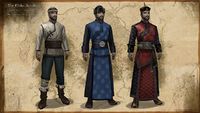
Orc clothing come in a variety of styles. Modern orcs tend to use a bias-cut-placket clothing,[114] or wear clothing befitting their role in society. Forge-wives may look to wear clothing made out of non-flammable gray scathecraw fibers that protects from forge embers or molten metal while performing their tasks.[115] To cover a suit of chainmail, orcs may opt to use robes.[116] For the wealthy, these robes would be made out of silk or other fabrics, which are then accented with steel or gold to convey the wearer's wealth and power.[117][118] Some orcish clans are known to tattoo themselves.[119]
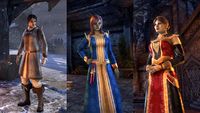
Orcs are famed for their skill in smithing. They consider themselves (as well as by many others) to be the best armorers in the world.[120] Orcish armor is built to be functional and utilitarian in nature. It is also typically thick and very heavy in that the sturdiest of other races may have difficulty moving in it. Orcish frames are well suited for their style of armor, whose tremendous weight they are said to work with since basically childbirth. Indeed, any difficulties wearing it such as immobility they see as yet another hardship they must endure. Their armor, especially their gauntlets and sabatons, are typically jagged and sharp with the intention of being utilized to cause misery upon enemies it may clash with. Fur is sewn into the folds to prevent self-inflected damage from their armor.[121] Words that have been used to describe the various types of orcish weapons are terrifying, jagged, crude, irregular, or unsubtle.[121][122] A certain variety of Orcish medium armor based on High Elven designs can be described as ornate steel plate worn over cloth padding, and the metal is light and comfortable in comparison to other steel plate armors. It is typically the medium armor of choice for both nobles and mercenaries in both east and west Tamriel, and requires paying a premium price to obtain.[123][124]
Orcs are well known for working with Orichalcum, which they use to forge armor and weapons. Like the rest of their creations, the resulting armaments are heavy and require great endurance to wield, but offer peerless strength and durability.[125] Orcs of the Trinimac Cult use ebony as a material for their armors and weapons in token of Lorkhan's blood when Trinimac tore out his heart. They believe that Zylvara, the great eagle bore the Golden Champion to his reckoning with the man-demon Quarvish.[93] Orcs also have skilled tanners who have a unique skill in tooling leather for exceptional flexibility and toughness.[125] Orcs are fond of shields, so much so that they have many traditional sayings dedicated to wielding them.[126] Though some orcs may shun magic, they recognize the utility of enchanted equipment and find enchantments to be visually appealing.[121]
Domesticated Animals[edit]
Echateres are large herbivorous mammals[77] with tusks, pointed hooves, and large antlers. Found mainly in Wrothgar, they serve the Orcs as livestock and beasts of burden. They provide meat, fur,[105] vellum,[127] and milk for the Orcs.[77][128][129] Orcs also have rare "shaggy giant centipedes" that serve as herdbeasts. These centipede-like creatures can live only at high altitudes on thrive on the alpine and sub-alpine forage.[7] A stereotype that orcs eat horses exists,[130] but orcish-made tapestries shows them being utilized for both hunting and in wars.[131][132]
Orcs train bears as guard mounts for their strongholds.[133] It is said that King Torug allied with the mightiest snow bear of Wrothgar after earning her trust. According to legend, Torug spilled his own blood to draw her out, brought echatere meat and clean water to feed her and brought fire to warm her. Coldwind accepted King Torug's offerings, for Torug had treated her as an equal, and not as a master.[134] The beast earned the name "Coldwind" by being fast and icily brave while serving as the king's mount in hundreds of battles, and also led to King Torug founding Orsinium's Bear-Rider cavalry. By taming Coldwind, Torug supposedly bent all the bears of the land to his will.[119] After many years of service, Coldwind grew weary so Torug found her a den in the far north so the bear could retire and pass on her bloodline to many powerful cubs.[135][136]
Orcs bred mammoths to be smaller to make them more manageable as livestock. They escaped and started breeding in the wild after orcish ranches containing them got raided by other orcs. These pocket mammoths as they have been dubbed are easily domesticated, especially if one is obtained during their youth.[137]
The Welwa inhabiting the wilds of Craglorn are often domesticated and armored by the Iron Orcs of the region, who use them as war beasts. The Iron Orc belief of labor long and hard has been instilled into their welwas, and will push their riders to the limit.[138][139]
The Seamount Clan claim that their ancestors tamed killer whales in the Abecean Sea and trained them for war. Riders of those whales were said to be capable of harpooning ships and steer them by using the strength of the animal, with evidence of this long-lost tradition surviving in siege gear that was later recovered in the Second Era.[140] They were also described as the fiercest raiders of the sea before they settled on Betony.[141]
Religion[edit]
Malacath[edit]
Do not kill your kin.
Do not attack without cause.
Those who break these rules must pay the Blood Price.
—Mauloch, Orc-Father
Mainstream Orcish religion is fairly unique to Tamriel in that it is monolatrous. Most Orcs revere Malacath, the Daedric Prince of Curses.[28] The orthodox belief among Wrothgarian and Wood Orcs is that Malacath is a broken Trinimac, transformed by Boethiah after he in some way stole the former Champion of Auriel's form.[3] There is debate among Orcs on whether he is Malacath, the Daedric outcast of Oblivion, or Mauloch, the Aedric outcast of Aetherius. Some even believe that he is both and has fittingly been cast out by both groups of divines.[142]
Regardless, after being reborn in his ashy prison, the newly-transformed Malacath cursed Boethiah and created the Code of Malacath, a central tenet to Orcish religion.[26] While exact interpretations vary between clans[80], his main commandments are as follows.
According to some priests, praying to Malacath for strength is futile because he cannot grant it. Instead, Malacath issues the challenge to claim strength from themselves.[143]
Upon death, followers of Malacath (or Mauloch) believe they will end up in Malacath's realm of the Ashpit. Here, Orcs are promised rewards of immortality, abundant food and drink, and constant battle deep within the Ashen Forge. Lending to the ambiguity of Mauloch's Aedric status, it is said that the Ashpit extends into Aetherius, allowing worthy Orsimer to freely transition into a more traditional afterlife.[144]
Trinimac[edit]
Some fringe members of Orsimer society choose to instead worship Trinimac. Some believe that Trinimac was the one that absorbed power from Boethiah, improving the Orsimer in the process,[43] while other worshippers think that Malacath and Trinimac are actually wholly separate entities, and that Malacath lies to keep them as pariahs under his thumb.[17] The latter belief has briefly risen to prevalence on numerous occasions, typically under newly-crowned kings of Orsinium who sought to form friendly relations with their neighbors, as was the case with King Kurog of Second Orsinium and King Gortwog gro-Nagorm of Nova Orsinium.[145][17] In both of these cases, the transition to Trinimac worship was brief and controversial, with Orcs reverting back to Malacath worship after their deaths.[31][17]
The followers of Trinimac believe that when they die, they ascend directly to Aetherius to join with their ancestors. The afterlife of Trinimac's faithful also consists of endless war and celebrations, but with a greater emphasis on once again spending time with family members who came before them.[3]
Boethiah[edit]
Boethiah holds a role in Orcish culture, despite the scarcity of preserved accounts of her veneration. Evidence and texts related to the worship of Boethiah by the Orcs exist. The esoteric text From Exile to Exodus discusses Boethiah's teachings to the Orcs.[6]
In the Merethic Era,[146] Boethiah was known to have Orcish followers. Among them, Dugikh emerged as a vessel for the Prince when Boethiah, alongside Azura, Mephala, and Hermaeus Mora, sought to banish Ithelia.[147][148]
Other[edit]
Orcish religion includes: Shamans,[149] Witch Doctors,[150] and Wise Women[44] as spiritual guides.
The Allfire is some form of obscure afterlife, seemingly associated with Orcs and goblin-ken; referred to in such curses as: "blast them to the Allfire!"[151]
In Orcish shamanism, a spirit called Gar-shutan (Sacred Beast) comes to the world in search of nobility. When it does, it appears in a vision to the Abbas (Seeker), the bravest warriors, through whispers, and has been seen in dreams hovering in the clouds. Complimentary to the Abbas is the Abasseen (Seeker's Companion), who may appear in these visions alongside the Abbas. When Gar-shutan appears, it does so always in a different form to test the clarity of the Abbas's vision. When called upon, it is customary for the Abbas to seek out the Abasseen and go to together on a holy quest to slay Gar-shutan. In combat, Gar-shutan tests the Abbas and thereby tests his people. The sacrifice of blood, theirs or beast's, is said to bring prosperity and joy to the Abbas's people. If neglected for too long, Gar-shutan may get tired of waiting, and may, inferably, remove the opportunity of letting the duo face the it in battle.[UOL 4]
Religious Orders and Cults[edit]
The Orcs have several religious orders and cults dedicated to the worship of Malacath and Trinimac.
Agra Crun: A religious order dedicated to protecting the sacred word of Malacath. Their name translates to Blood Shield in the common tongue. The group operates in secrecy, but for the few that know of them, they are seen as a beacon of Light. [152]
Malacath's Brutal Breed: This was a group of fanatical Malacath followers that existed during the First Era. Their main purpose was to hunt down and murder Bretons and Redguards for every real and imagined slight perpetrated by them against the Orcs. Legends about the Cult say the group sacrificed an entire Breton village to the Ashpit.[153]
Vosh Rakh: A group of fanatics dedicated to the worship of Trinimac. Their goal is to bring the Orcs back to their Aldmeri roots. Vosh Rakh in Orcish translates to Blade of Courage, which directly refers to Trinimac's legendary weapon, Penitent. They see themselves as the Sword made manifest, and their goal is to rid orcish society of the traditions that held the Orcs back for many years. [154]
Wrathful Flame: A religious order dedicated to lighting Malacath's Pyre in the ruins of the first Orsinium.[155]
Death[edit]
When an Orc dies, his or her remains will be burned down to ashes, which can be handled by their kin. Ashes from chiefs, kings and elders are usually forged into swords and shields, or any other item that their relatives or successors may want to remember the departed ones.[156][103] This practice is called the "beshkar-nor," the death-forge; it is traditionally reserved for Orcs of great stature, such as a leader, elder or hero. The blood is either drained from the body, or the body is reduced to ash and then saved for the processing of forging tools, weapons and armor.[157]
The ashes of the Orcish dead are customarily placed under a cairn, out in the field, under the open sky. Their arms and armor are placed over this cairn, and their relatives would then come to honor their ancestors. Burial is not a practice among the Orcs, although they respect other races' traditions.[158][141] A few hours after a family repays their respects, the bodies of the dead who are not cremated and are left where they fell, despite popular lore to the contrary, are removed from the area, this is done to prevent the dangers of decay and disease; what happens to the bodies afterwards is a secret the Orcs are not willing to tell outsiders.[157]
The mountain of Sorrow, in Wrothgar, is an ancient burial site for Orcs. Grand tombs, cairns, and wedge tombs, were often placed on the mountain by the Orcs, at the expense of many lives due to the many dangers of the mountain. Only the strongest Orcs were able to survive the challenges of the mountain. The corpses of those who died on the mountain were left behind. Legends state that seven Orcish clans were wiped out, in the process of building the tomb of King Torug. Eventually the Orcs stopped using Sorrow as a place of burial.[157][102]
Another famous burial site is the catacombs of Honor's Rest, in southern Wrothgar. This extensive mausoleum was built by Orc, Breton, and Redguard masons after the destruction of the first Orsinium. The corpses of Bretons and Redguards and the ashes of the Orcs who died in the long siege were placed here, including those of the heroes and rivals Baloth Bloodtusk and Gaiden Shinji. The ruins were hidden and remained undiscovered until the reign of King Kurog in the Second Era.[159][160][161]
- → For more detailed information see: Orc Death Beliefs
Artifacts[edit]
Helm of Oreyn Bearclaw[edit]
The Helm of Oreyn Bearclaw, also known as the Helm of Kharag gro-Khar, is a prized artifact with a history of conflicted attribution. The helm itself is an engraved skull, which is enchanted to improve the wearer's agility and endurance.
Those that claim it is a Bosmeri artifact know it by the former name, and attribute it to the legendary Dunmer hunter of Valenwood, Oreyn Bearclaw of the Oreyn bloodline. Legends claim that Bearclaw single-handedly killed Glenhwyfaunva, the witch-serpent of the Elven wood, and thus brought peace to his clan. He would bring the helm and his name further reverence by performing many more great deeds, until he lost his life to the Knahaten Flu. After Bearclaw's demise, his helm stood as a monument of his stature, although it was eventually lost after his clan split.
Those that call the helm by its latter name believe that Oreyn was falsely credited, and that the feats were actually performed by his Orc friend, Kharag gro-Khar, hero of the Shatul Clan. Thus they consider it an Orcish artifact, and the relic has been claimed by Malacath himself. Those that believe the former story however, state that Kharag stole both Oreyn's helm and reputation, and thus both camps have tried to claim it.
Mace of Molag Bal[edit]
Though not of cultural relevance to the Orcs, the origins for the Mace of Molag Bal can be traced back to when Molag Bal deceived an Orcish blacksmith and enslaved him in pits of Coldharbour. The blacksmith was turned into a Soul Shriven and forced to forge the mace.[UOL 5][162]
Manshrieker[edit]
The Manshrieker was a holy weapon of war for the Orcs.[163]
Gallery[edit]
Appearances[edit]
Miscellaneous[edit]
Notes[edit]
- Orcs originate in the works of J. R. R. Tolkien's legendarium, with developers commenting that any appearance of Orcs in fantasy are going to be influenced on some level by Tolkien. There were early attempts to differentiate Orsimer from the Orcs of Middle-earth and move away from the noble savage trope, with the Samurai-style Orcish armor from Daggerfall inspiring an idea to explore Orsinium being a conduit to an extraplanar dimension containing an advanced Atlantis-type "Orc Prime" (similar to the extraplanar backstory of the Goblins), where honored Shoguns gave mystical orders and wore strangely-sculpted Trinimasks.[UOL 2] While this idea did not have much movement behind it, it did have some influence in other parts of the series, such as masks being a commonplace Orcish decoration (some enchanted to have magical powers)[164] and certain mythological stories describing Orcs originating as a race while enduring the metamorphosis in the Ashpit.[6]
See Also[edit]
- Orc Names
- For a list of notable Orcs, see here.
- For game-specific information, see the Arena, Daggerfall, Morrowind, Oblivion, Skyrim, Elder Scrolls Online, Legends, and Blades articles.
Books[edit]
- Civility and Etiquette: Wood Orcs I by Coristir, Sage Sojourner — An Altmer guidebook outlining the correct social protocols when dealing with the Wood Orcs
- The Code of Mauloch — A description of the unwritten rules of the Orcs
- In the Company of Wood Orcs by Sisarion — Extract from a Bosmer's journal recounting his experience with Wood Orcs
- Crafting Motif 8: Orc Style by Doctor Alfidia Lupus — Notes on materials and motifs used with Orcish armor
- From a Breton travel journal — An observer's notes on Orcish battle preparation
- How Orsinium Passed to the Orcs by Menyna Gsost — The story of how Gortwog won the land to the north of Wayrest
- An Orc's Guide to Tamriel by Luruk gro-Bozgor — A guidebook for Orcish travelers to Tamriel
- Orcs: Monsters or Misunderstood? by Taleon Mythmaker — A brief essay on the creation and virtues of the Orcish race
- Orcs? Could Be Worse — A Breton's thoughts on the benefits of having Orcish allies
- Orcs of Skyrim by Thora Far-Wanderer — A history of the Orcish settlers and strongholds of Skyrim
- Orcs of Tamriel, Volume 3 by Grassius Vilco — A treatise on the Iron Orcs of Craglorn
- The Pig Children by Tyston Bane — Discusses the history of the Orcish threat in the Iliac Bay
- Pocket Guide to the Empire, 1st Edition: The Wild Regions — Imperial Geographical Society, 2E 864
- Pocket Guide to the Empire, 3rd Edition: Orsinium — Imperial Geographical Society, 3E 432
- The Red Paint — How Orcs make their war paint
- Return to Orsinium by Immigration-Wife Uulitag gra-Orsinium — A rallying pamphlet urging Orcs to return to Orsinium
- Sayings of the Wise — Orcish proverbs
- The True Nature of Orcs — Book detailing the Orsimer race and their origin
- Varieties of Faith: The Orcs by Brother Mikhael Karkuxor of the Imperial College — A summary of the religion of Orcs
- Vorgrosh Rot-Tusk's Guide to Dirty Fighting by Vorgrosh Rot-Tusk — An Orcish guide to combat
References[edit]
- ^ a b c d Father Of The Niben — Florin Jaliil
- ^ a b c d e f The True Nature of Orcs
- ^ a b c d e f Varieties of Faith: The Orcs — Brother Mikhael Karkuxor of the Imperial College
- ^ Torug at the Summit, Complete Translation
- ^ Lashburr Tooth-Breaker's dialogue in ESO
- ^ a b c d e f From Exile to Exodus — Tarvyn Aram
- ^ a b c d e f g h i Pocket Guide to the Empire, 1st Edition: The Wild Regions — Imperial Geographical Society, 2E 864
- ^ a b c Orc racial description in Morrowind
- ^ Orc racial description in Oblivion
- ^ Discerning the Transmundane quest in Skyrim
- ^ a b Generic dialogue on the topic of Betmeri in Morrowind
- ^ a b c Before the Ages of Man — Aicantar of Shimerene
- ^ a b Thendaramur Death-Blossom Answers Your Questions — Thendaramur Death-Blossom
- ^ a b c Arena Player's Guide description of Orcs
- ^ a b Bonerock Cavern loading screen in ESO
- ^ The Pig Children — Tyston Bane
- ^ a b c d e f g Pocket Guide to the Empire, 3rd Edition: Orsinium — Imperial Geographical Society, 3E 432
- ^ a b Five Songs of King Wulfharth
- ^ a b c Generic dialogue on the topic of Orc in Morrowind
- ^ Orc description in Skyrim
- ^ Varieties of Faith: The Nords — Brother Mikhael Karkuxor of the Imperial College
- ^ The Doors of Oblivion — Seif-ij Hidja
- ^ Rescue Iszara story quest in Redguard
- ^ N'Gasta's Spellbook — N'Gasta
- ^ Orc racial description in Castles
- ^ a b Mauloch, Orc-Father — Ramurbak gro-Abamath
- ^ The Changed Ones
- ^ a b c The House of Troubles
- ^ The Fall of Trinimac — The Faithless One
- ^ a b The Anticipations — Anonymous
- ^ a b c Lord of Souls — Greg Keyes
- ^ Map of Clans
- ^ Dra'bul loading screen in ESO
- ^ Pocket Guide to the Empire, 1st Edition: The Wild Regions — Imperial Geographical Society, 2E 864
- ^ a b c d Orcs: Monsters or Misunderstood? — Taleon Mythmaker
- ^ Gathering Force: Arms and Armor of Tamriel, The Goblin Filth, Grutbug the Unhealthy
- ^ The Improved Emperor's Guide to Tamriel: Elsweyr — Flaccus Terentius, 2E 581
- ^ Malacath and the Reach — Kyrtos
- ^ The Real Barenziah, v 3 — Anonymous
- ^ Discerning the Transmundane quest in Skyrim
- ^ Veloth the Pilgrim — Cascius the Proud
- ^ King Kurog's dialogue in ESO
- ^ a b Villager Dialogue during The Heretic in Blades
- ^ a b c Orc Strongholds Generic Dialogue in Skyrim
- ^ 16 Accords of Madness, v. XII
- ^ The War of the First Council — Agrippa Fundilius
- ^ A Life of Strife and Struggle — King Laloriaran Dynar
- ^ Morkul Descent loading screen in ESO: Orsinium
- ^ The Real Nerevar
- ^ Redguards, History and Heroes — Destri Melarg
- ^ a b Wayrest, Jewel of the Bay — Sathyr Longleat
- ^ a b Bangkorai, Shield of High Rock — King Eamond
- ^ Thulgeg's March — Kraltha the Rememberer
- ^ a b Malacath's dialogue in ESO: Orsinium
- ^ The Great Siege of Orsinium
- ^ The Mirror — Berdier Wreans
- ^ Once — Beredalmo the Signifier
- ^ From The Memory Stone of Makela Leki — Makela Leki
- ^ a b c Events of ESO
- ^ Crafting Motif 8: Orc Style — Doctor Alfidia Lupus
- ^ High King Emeric Answers Your Questions — High King Emeric
- ^ The Royal House of King Eamond — Seneschal Derric Andras of Castle Evermore
- ^ a b The Fury of King Ranser — Wafimeles Masteret (Lorekeeper)
- ^ a b Guide to the Daggerfall Covenant
- ^ a b c d e Orcs of Skyrim — Thora Far-Wanderer
- ^ Marisette's dialogue in ESO
- ^ Gerard Althen's dialogue in ESO
- ^ Orcs? Could Be Worse
- ^ Orcs: The Vermin Among Us — Absolon Sorick
- ^ How Orsinium Passed to the Orcs — Menyna Gsost
- ^ The Warp in the West — Ulvius Tero
- ^ Rumors in Oblivion
- ^ Loading screen in Skyrim
- ^ Events of Blades
- ^ Hunt-Master Bulozog's dialogue in ESO: Imperial City
- ^ Events of Skyrim
- ^ a b c Orzorga's dialogue during Kindred Spirits in ESO: Orsinium
- ^ Interview with a Dark Elf
- ^ The Wraith's Wedding Dowry — Voltha gra-Yamwort, translated by Apthorne
- ^ a b c d e The Code of Malacath — Amanda Alleia, Mercenary
- ^ Judicial Blood Price Gold Scale item description in ESO
- ^ Orcish Ledger of Significant Grudges item description in ESO
- ^ a b Khazasha's dialogue in ESO: The Deadlands
- ^ Guide to Cheydinhal — Alessia Ottus
- ^ Guide to Bravil — Alessia Ottus
- ^ Guide to Skingrad — Alessia Ottus
- ^ A Dance in Fire, Chapter 2 — Waughin Jarth
- ^ Notes on Racial Phylogeny — the Council of Healers, Imperial University
- ^ Journal of the Lord Lovidicus — Lord Lovidicus
- ^ The Sport of Clans
- ^ Vengeance Day Dress costume description in ESO
- ^ Breda's dialogue in ESO
- ^ a b Crafting Motif 22: Trinimac Style — the Venerable Uugus, Priest of Trinimac
- ^ Curator Umutha's dialogue in ESO: Orsinium
- ^ From a Breton travel journal
- ^ The Red Paint
- ^ Arithiel's dialogue in ESO
- ^ The Taking of Abamath
- ^ Ghorbash the Iron Hand's dialogue in Skyrim
- ^ Oshgura's Destruction Journal — Oshgura
- ^ Orcish skill in Daggerfall
- ^ a b c Kharsthun's dialogue in ESO: Orsinium
- ^ a b Chief Bazrag's dialogue in ESO: Orsinium
- ^ The Elder Scrolls: The Official Cookbook — Chelsea Monroe-Cassel
- ^ a b All About Echatere — Stugbrulz gro-Shatul
- ^ Rulfala's dialogue in ESO: Orsinium
- ^ Grudash gro-Shugharz, Orcish stonemason — Grudash gro-Shugharz
- ^ City Solicitor's dialogue in ESO: Orsinium
- ^ Orsinium Pink Zinfandel Decanter item description in ESO
- ^ a b Orcish Furnishings in ESO
- ^ King Kurog's dialogue during The Anger of a King in ESO: Orsinium
- ^ Orcish War Totem description in ESO
- ^ a b Crafting Motif 23: Malacath Style — Forge-Wife Gurzbog gra-Gulog
- ^ Eternity Tunic with Pants costume description in ESO
- ^ Forge-Wife's Impervious Frock costume description in ESO
- ^ Lady Eloisse Answers Your Questions — Lady Eloisse, Fifth Countess Manteau
- ^ Brilliance Brocade Robes costume description in ESO
- ^ Summit Lord's Silken Robes costume description in ESO
- ^ a b Curator Umutha's dialogue in ESO: Orsinium
- ^ Orc dialogue topic in Morrowind
- ^ a b c Arms and Armor of the Orcish Champion, Gushagub Gro-Shugdurbam
- ^ Orcish quality in Blades
- ^ Items Codex on elderscrolls.com
- ^ Garothmuk gro-Muzgub's dialogue in Morrowind
- ^ a b The Improved Emperor's Guide to Tamriel: Northern Bangkorai and the Mountains — Flaccus Terentius, 2E 581
- ^ Old Orc Sayings: Shields — Roald Kenway
- ^ Fine Echatere Vellum contraband item in ESO
- ^ Bulfor the Cheesemonger's existence and dialogue in ESO
- ^ Dark Elves, Dark Hearts — Bakozog gro-Shakh
- ^ Snak gra-Bura in Oblivion
- ^ Orcish Tapestry, Hunt depiction in ESO
- ^ Orcish Tapestry, War depiction in ESO
- ^ Kyne's Challenge, Skyrim — The Imperial Library
- ^ A Cold Wind From the Mountain quest in ESO: Orsinium
- ^ Coldwind's Skull
- ^ Coldwind's Den loading screen in ESO
- ^ Pocket Mammoth pet description in ESO
- ^ Longhair Welwa's pet description in ESO
- ^ Iron Orc Welwa mount description in ESO
- ^ Cornerstone of Reman II antiquity codex entries in ESO: Greymoor
- ^ a b Rozag gro-Khazun's dialogue in ESO
- ^ Shrine of Mauloch loading screen in ESO
- ^ Thazeg's dialogue in ESO
- ^ On Orcs and the Afterlife — Erisa Moorcroft, Scholar, Comparative Religious Studies
- ^ Events of ESO
- ^ Curate Gadayn's dialogue in ESO
- ^ Acolyte Dugikh's dialogue in ESO
- ^ Events of Prisoner of Fate in ESO
- ^ Orc Shaman in Daggerfall
- ^ Dialogue during An Unexpected Journey Part II quest in Daggerfall
- ^ Olpac Trailslag's dialogue during Trailslag's Goods quest in Shadowkey
- ^ Azrath's dialogue in ESO: Orsinium
- ^ Malacath's Band of Brutality Antiquity Codex entries in ESO: Greymoor
- ^ Vosh Rakh — Ugdorga, the King's Scribe
- ^ Flames of Forge and Fallen quest in ESO: Orsinium
- ^ Priest Uugus' dialogue in ESO: Orsinium
- ^ a b c Strange Rituals of the Orsimer — Chaplain Jorden, Priest of Arkay
- ^ Brulak's dialogue in ESO: Orsinium
- ^ The Ashes of Our Fathers quest in ESO: Orsinium
- ^ Lozruth's dialogue in ESO: Orsinium
- ^ Crafting Motif 14: Daedric Style — Seif-ij Hidja
- ^ The Cursed Weapon quest in Daggerfall
- ^ Guthrag's Mask
Note: The following references are considered to be unofficial sources. They are included to round off this article and may not be authoritative or conclusive.
|
|||||||||||||||||||||||||||||||||||||||||||
